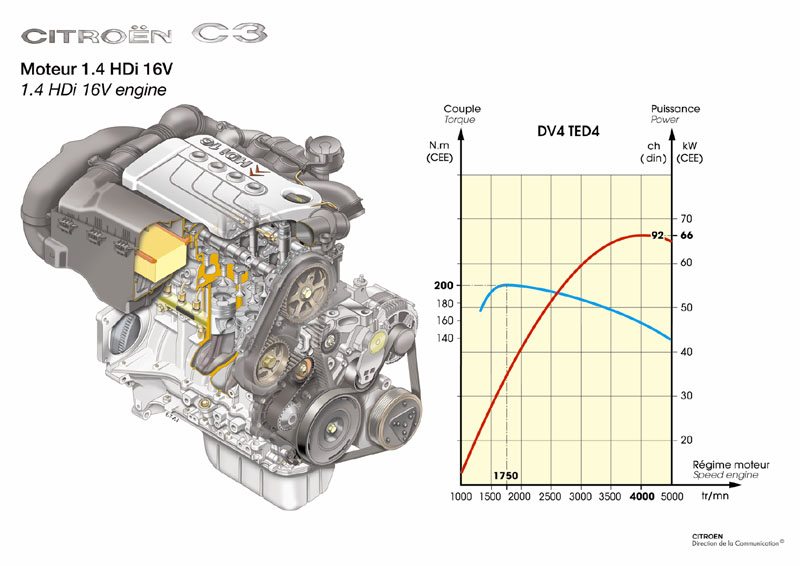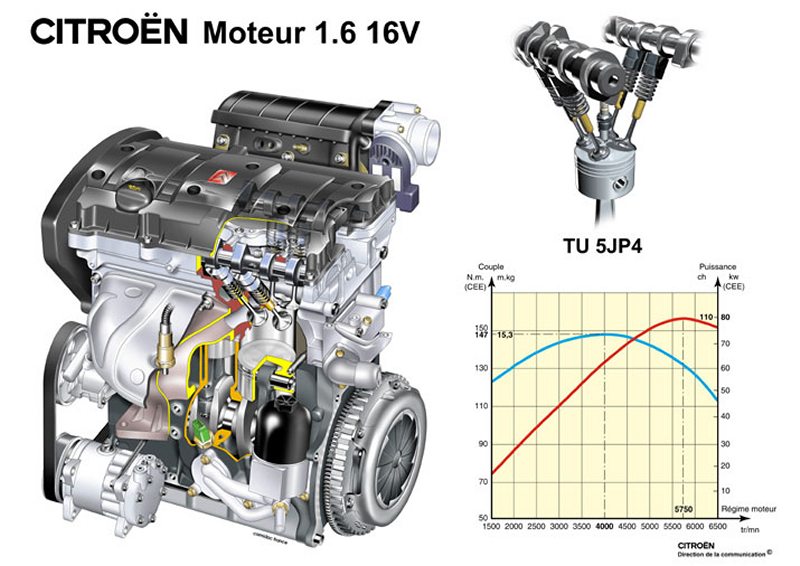|
||||||||||||||||||||||

THE
ADVANTAGES OF THE 1.4 HDi 16V ENGINE
THE
CITROEN C3 15 THE FIRST VEHICLE TO BE FITTED WITH THE NEW
GENERATION 1.4 HDi 16V ENGINE DEVELOPED THROUGH THE COOPERATION
AGREEMENT BETWEEN PSA PEUGEOT CITROEN AND FORD. AS A RESULT OF
THE TECHNOLOGICAL CHOICES MADE (CYLINDER HEAD DESIGN,
SECOND-GENERATION COMMON-RAIL SYSTEM, VARIABLEGEOMETRY
TURBOCHARGER AND DIRECT INJECTION), THIS ENGINE GAINS A LEVEL OF
QUIET, ASSURED PERFORMANCE HITHERTO SEEN ONLY IN HIGH-SPEC
VEHICLES.
The performance of
the 1.4 HDi 16V engine is quite simply astonishing for a vehicle
in this category, particularly with respect to mid-range
acceleration and response, these being the conditions most
frequently encountered in use.
Easy and
enjoyable to drive, this engine has a strong and appealing
personality of its own.
Thanks to the
second-generation common-rail system, the 1.4 HDi 16V combines
improvements in torque, performance, fuel consumption and
pollutant emissions, with quiet operation and compact design.
OPTIMISED
PERFORMANCE AND EFFICIENCY
The 1.4 HDi 16V
engine develops 66 kW EEC (92 bhp DIN) at 4,000 rpm and torque
of 200 Nm at 1,750 rpm. It is the most efficient engine in its
segment (47 kW/litre and 66 bhp DIN/litre).
The reduction
in weight of the moving parts contributes to engine performance
by making it possible to increase speed more quickly, in the
same way as with a petrol engine.
Equipped with
second-generation common-rail injection technology, a variable
geometry turbocharger (multivalve technology) and an air-to-air
intercooler, this new engine applies specific control laws,
through which it is able to adapt to driver behaviour by
adjusting output in accordance with the pressure placed on the
accelerator pedal.
LOWER
CONSUMPTION
The 1.4 HDi 16V
is an engine of parsimonious fuel consumption (4.3 litres/100 km
in a combined cycle) as a result of its low capacity, advanced
design materials (aluminium alloys and composite materials) and
lower internal friction combined with the use of common-rail
direct injection technology. One way of cutting fuel consumption
is to reduce the weight of vehicle components. With a total
weight of around 98 kg, the 1.4 HDi 16V engine is a real
"featherweight". This reduction in weight was achieved through
the general use of aluminium alloys and composite materials.
The cylinder
block and cover are made of pressure cast aluminium, with
cast-iron bearings and sleeves inserted during the casting
process.
The cross-flow
cylinder head, comprising four valves per cylinder, is made up
of two sections: a tower gravity-cast section and an upper
section bearing the pressure-cast camshaft.
The camshaft
features sintered cams that are fitted onto a steel tube. This
design reduces the weight of the assembly by 30% or 1.3 kg.
A number of
components are made of composite materials, including the intake
manifold, cylinder head cover, water inlet and outlet housings
and the treatment system for crankcase fumes.
All the moving
parts (such as the crankshaft, rods and pistons) have been
optimised with a view to reducing size and weight. The diameter
of the valve stems, for example, is 5.5 mm. This is a size more
commonly found in small, high-performance petrol engines.
Another factor that plays a role in reducing overall consumption
is the reduction in friction losses. The valves are controlled
by finger followers that cut fuel consumption by between 1.5%
and 2% depending on engine speed.
Last, the
high-pressure common-rail injection system provides a fine,
high-precision fuel spray and contributes to the management of
fuel consumption. A single rail supplies the four injectors with
fuel at a pressure varying from 250 bars to 1,400 bars.
These new
electronically controlled injectors calculate the timing and
quantity of fuel injection with precision, particularly for the
pilot injection (or preinjection).
ACOUSTIC
COMFORT AND VIBRATION CONTROL
The 1.4 HDi 16V engine offers excellent acoustic comfort and
vibration control as a result of its specific characteristics
and its positioning under the bonnet of the C3, using a system
of specialty adapted shims and mounts.
The pilot
injection (small quantity of fuel injected before the main
injection) gradually increases the temperature in the combustion
chamber and brings about gradual combustion with a significantly
higher level of acoustic comfort, notably at idle.
The highly
elaborate exterior shape of the cylinder block - obtained by
pressure casting - and the precise ribbing used to stiffen the
lower part, also contribute to the low emissivity of the engine.
Last, the use of
lighter mobile parts reduces engine inertia and so improves
vibration control.
RESPECT FOR THE ENVIRONMENT
Combining
new-generation common-rail technology with improved combustion
management and reduced weight, these low-capacity diesel engines
enhance performance levels and bring significant cuts in fuel
consumption and C02 emissions with no trade-off in vehicle
performance.
The 1.4 HDi 16V
Engine emits 112 g of CO2 per km, an exceptional result in view
of its performance characteristics.
COMPACT
DESIGN
The compact
dimensions of the engine made it possible to modify the layout
of parts underneath the bonnet with a view to increasing
passenger protection.
The layout of
the parts around the engine such as the exhaust, accessories and
air-intake has been defined to take up less space.
The air supply
system behind the engine, which is made of composite materials,
provides a compressible area in the event of impact.



